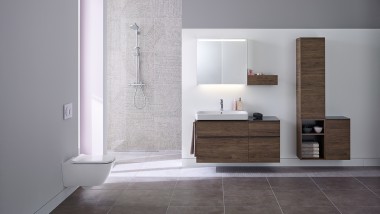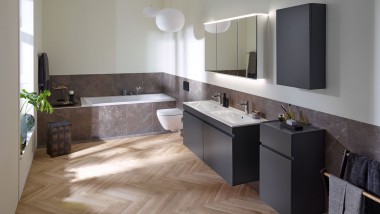How to prevent legionella in drinking water
What are legionella?
Legionella are bacteria that we really don’t want to have in our bodies. They are pathogens and can lead to infections, particularly in people with weakened immune systems.
Because they spread in pipes with drinking water, it is important to keep an eye on their habitat and the quality of our drinking water.
How do legionella end up in water?
Legionella get into the drinking water via the domestic water supply. They only become dangerous to humans when the small quantities of legionella found in the pipes multiply significantly. Water temperature and stagnation as well as the nutrient supply in drinking water are the decisive factors in the spread of legionella. Temperatures of between 25 and 50 degrees Celsius are the perfect conditions for such bacteria to multiply – but this is only an issue if the water is not replaced regularly.
Commissioning a company specialising in water analysis is a good idea for testing legionella in your property.
Legionella should not be feared – or underestimated
Legionella are bacteria that can cause disease. When you shower, they are rinsed out of the shower head in tiny water droplets. The pathogens enter the lungs in water via the respiratory passages. In healthy people, they are unlikely to cause illness. However, people with a weakened immune system can be at risk.
What illnesses do legionella in water cause?
Legionella can cause legionnaires’ disease. This is a serious lung infection, with symptoms including the rapid onset of headaches and chest pain, coughs, chills and fever. The lung infection is often severe and can last around four weeks. The long-term effects are unknown.
Are infections caused by legionella common?
In most countries, reported cases of legionnaires’ disease caused by legionella are below two instances per 100,000 people according to the European Centre for Disease Prevention and Control. The European average is 1.8 instances. In Germany, the rate is as low as 1.7 instances per 100,000 people.
Tips on low-legionella drinking water
The following measures are used to fight the pathogens:
- Ensure that the toilet is flushed about once every 24 hours. This can prevent the spread of pathogens even when the temperatures are favourable.
- Set your boiler to at least 55 °C. This means bacteria cannot multiply in the boiler.
- The installation of a hygiene flush unit is a good idea in properties that are not used regularly. These units can be programmed so that the pipes are flushed regularly and the water is replaced.
- Clean the aerators on your taps and the shower head regularly.
Added value to you Get inspiration for your new bathroom
Inspiration tool
Discover ideas and functions in the modern bathroom and choose what you like and what is important to you. In just a few steps, you can bring together the elements of your dream bathroom.
Contact us
If you have any questions, simply fill out the contact form.
3D bathroom planner
Plan your bathroom online using the 3D view and choose between various options. You can also request a quote to turn your dream into a reality.
Newsletter
Our newsletter will provide you with insights and tips on how your bathroom can simplify your day-to-day life.
Always staying up to date
Important – flush out tap and shower pipes
In most buildings, the toilets are the last sanitary installation in the chain. If the toilet is flushed, the water is also replaced in the shower and washbasin taps.
The pipes should be flushed out every 24 to 72 hours in order to prevent the spread of legionella.
If you have been away from home for a while, we would recommend you don’t drink water straight out of the tap. Rather, you should flush all drinking water pipes for about two minutes. This includes taps and shower sprays in particular. Avoid being in the bathroom when the water is running.
Legionella can also nest directly at the point of use. This is why you need to regularly free shower sprays and tap aerators – the nozzles on the taps in the kitchen and bathroom – from limescale.
Ensure drinking water hygiene with the correct planning
If there is a legionella problem, it could well be worth your while to use a temporary hygiene flush unit – such as the Geberit HS10 model. Without any major conversion work and without great expense, it can be fitted at the relevant pipe section to re-establish the quality of your drinking water.
A fixed hygiene flush unit is recommended when the property is not used regularly. This prevents excessive stagnation times in the drinking water pipes. Hygiene flush units can be installed either in the toilet cistern or externally at a suitable point in the water supply system. Hygiene flush units can be programmed directly on the product or, depending on the model, set and controlled using the Geberit Control app
Prevent legionella by regularly inspecting the domestic water filter
Home owners should have their domestic water filter regularly checked by a plumber. They can then recommend a replacement, when necessary.
Tenants usually do not have to take care of this, as the inspection and replacement is normally the responsibility of the caretaker.
Pay attention to the water temperature
Water temperatures of between 25 and 50 degrees Celsius are the perfect conditions for legionella to multiply. The bacteria stop multiplying abruptly at 50 degrees, while the time needed for them to double decreases at below 25 degrees. In summer in particular, there is a significant risk of the cold water pipes in the danger area heating up.
Steps can be taken primarily at the boiler. Setting the hot water temperature to at least 55 °C at all times ensures that the bacteria cannot multiply.
Newsletter Register now
Stay up to date
Our newsletter provides fascinating insights and handy tips on how your bathroom can make your life easier.
Which bathroom is the right one for you?
But, what exactly are your needs? Is space, cleanliness or the design important to you? Would you like user-friendly products or would you prefer that extra degree of comfort that the Geberit AquaClean shower toilet, for example, has to offer? Or would you prefer a universal design? No matter what your needs are, we simplify your daily routine with our clever bathroom solutions.
More space in the bathroom
Higher standard of cleanliness in the bathroom
More functional design in the bathroom
Greater comfort in the bathroom
Increased accessibility in the bathroom
Improved usability in the bathroom














